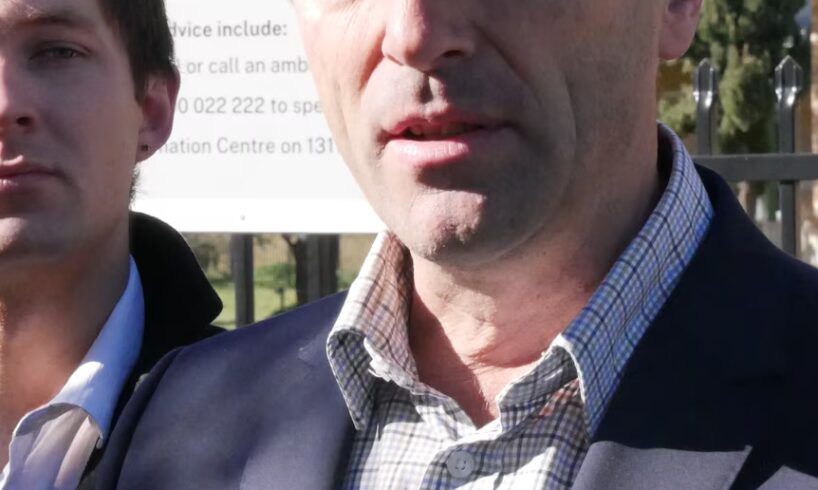
Narribri Shire in northern New South Wales has less than two weeks of water available owing to contamination of its regular supplies, according to local authorities.
The council, two hours north-west of Tamworth, relies on water from three bores for its population of almost 13,000 people.
Earlier this year, two of those bores had to be shut down after they tested positive for per- and polyfluoroalkyl substances (PFAS), or ‘forever chemicals”.
Within a week, the council twice upgraded its water restrictions, which now stand at level four, which limits the use of hoses and encourages conservation.
“We are relying on one source of water, and for a town the size of Narrabri, it’s unacceptable,” said Narrabri Shire’s Mayor Darrell Tiemens.
“The NSW government is working with us, but it’s taking too long.”
New water guidelines
In June, guidelines for Australian Drinking Water were updated to recommend lower acceptable values of PFAS in drinking water.
As a result, Narrabri’s Tibberena and Killarney bores were switched off in July, following detections of unacceptable amounts of PFAS.
NSW Health describes forever chemicals as those used to make products that resist heat and which can stay in water and soil for an extended time after being used.
PFAS chemicals were traditionally used in products like firefighting foam, non-stick cookware, and cleaning products.
Narrabri Shire’s only operational bore, Elizabeth Bore, sources water from the Namoi Street Reservoir to supply the township with drinking water.
Two of Narrabri’s three water bores show unacceptable levels of PFAS. (ABC Rural: Daniel Fitzgerald)
“We warned the NSW government that we were very concerned about the new water guidelines … we are disappointed that 10 months after that, we’re facing these types of restrictions,” Cr Tiemens said
“Council doesn’t use PFAS, and we refuse to wear the blame for this.”
Findings from a recent inquiry into PFAS contamination in NSW water supplies recommended NSW Health support Narrabri residents to get blood tests after PFAS was first detected in the bores in 2024.
Greens MLC Cate Faehrmann (centre) chaired the inquiry into PFAS contamination in waterways and drinking water in NSW. (ABC Central West: Xanthe Gregory)
Narrabri Shire made a submission to that inquiry, highlighting the looming danger to its water supply.
Cr Tiemens fears the council will be left with the cost to fix the contaminated bores or install new ones.
“This is water crisis not of our making, we are renewing our calls to the state government [for help].”
Water minister pledges assistance
Minister for Water Rose Jackson said in a statement that “everything possible” was being done to assist Narrabri Shire Council.
“We’re open to all options, including alternative bore sites or water treatment solutions, and we will work with the council to fund and deliver them,” she said.
“We are ready to step in immediately with additional measures like water carting, bottled water distribution, and supplementary water purification systems, if they are required.”
Earlier, a spokesperson from the Department of Climate Change, Energy, the Environment and Water (DCCEEW) said in a statement that $50,000 in emergency funding had been made available to deliver a new pump to the operational bore.
The department said the state funding was intended to help councils experiencing water security issues, like PFAS contamination.
“We work closely with councils to identify long-term water solutions, including alternative bore sites and fast-tracking licence approvals where necessary,” the spokesperson said.
DCCEEW said the new infrastructure would double the bore’s pumping capacity from 45 litres of water per second to 80 litres.
“We are also looking for additional funding to find a solution,” DCCEEW’s director of water utilities, Jane Shepherd, told the ABC New England North West breakfast show.
“We are determined on finding where the PFAS contamination is in Narrabri … we don’t want to drill a new bore if it is also going to be contaminated.”
However, Narrabri Shire Council general manager Eloise Chaplain said the mandatory water restrictions would need to bite before the new pump could be installed.
Cr Tiemens explained the bore would need to be at 80 per cent capacity to act as a “buffer”, to cover the estimated 72 hours it would take to install the pump.
However, this is seen as only a temporary solution, with a possible temporary water treatment facility being explored by both council and DCCEEW.
Residents have been asked to use handheld hoses between 7pm and 7am, refrain from washing their cars or filling their pools without approval.





